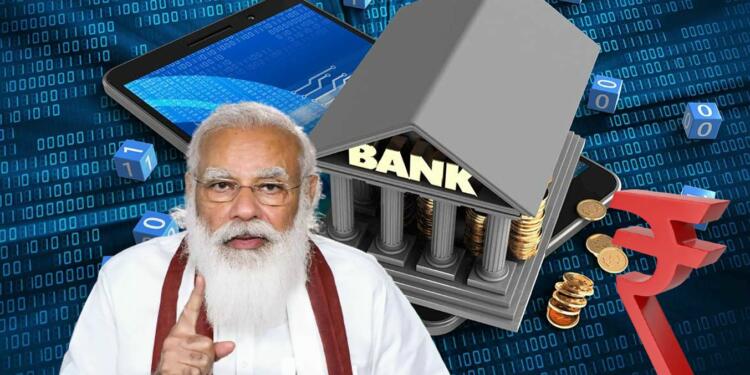- From being a laggard in digital payments, today India does more digital payments than the USA, UK, and China combined.
- The idea behind digital banks is that cost of capital can be significantly lowered because the investment in real estate and human servicing will be zero.
- The digital banks will bring the cost significantly down, because expenditure on real-estate and non-technical human resources will be near zero as compared to today’s banks
In the last few years, fintech (financial technology) has grown exponentially in India. From being a laggard in digital payments, today the country does more digital payments than the USA, UK, and China combined. Thanks to the efforts of the last seven years, India has already prepared the underlying infrastructure for full-stack digital banking.
A recent policy paper by NITI Aayog moots full-stack digital banking to lower the cost of capital increasing accessibility to the banking services, especially in terms of lending to MSMEs (Micro, Small, and Medium Enterprises). A large number of neo-banks (fintech startups working in collaboration with non-banking financial companies) like Open, Jupiter, RazorpayX, Fi, Freo and Niyo, emerged in India in the last few years, but there is a limitation to this model because these banks cannot accept deposits.
Also read: The Digital Guru of the world: India leaves China and America behind in digital transactions
As per the report released by NITI Aayog, the current model has limitations to revenue, and the cost of capital will remain high. “On the other side of the balance-sheet, absent the licensing framework, Neobanks cannot issue low-cost deposits and are constrained to rely on expensive equity capital to fund innovation and operations”, reads the paper by NITI Aayog.
The idea behind digital banks is that cost of capital can be significantly lowered because the investment in real estate and human servicing will be zero. If this primary goal is not met, there is no use of full-stack digital banks, because all the other digital services are being provided by existing banks also.
The moat banks have today is that it is very very tough to become a bank. Yeah, you can be a Small Finance Bank, Payments Bank, Neo Bank, but you can never compete with a full-fledged bank due to all the restrictions. But looks like there is hope that the future is different. https://t.co/n9CqYS3fQX
— Nithin Kamath (@Nithin0dha) November 24, 2021
“The moat banks have today is that it is very very tough to become a bank. Yeah, you can be a Small Finance Bank, Payments Bank, Neo Bank, but you can never compete with a full-fledged bank due to all the restrictions. But looks like there is hope that the future is different,” tweeted Nithin Kamath, founder of brokerage firm Zerodha, quoting the RBI paper.
Harshil Mathur, co-founder and CEO of Razorpay, which runs an MSME neobank, RazorpayX, said that the industry has seen this as a welcome move. “Today neobanks operate as technology layers. What this paper is proposing is that over time we can foray into full-stack banking”, he said.
“The Restricted Digital Business bank licence is exactly what neobanks are doing today. It will be a really good move to allow neobanks to secure a full-stack licence,”said Jitendra Gupta, founder of neobank Jupiter, which provides tech for retail banking services.
In the last few years, India has emerged as a global leader in the financial technology (fintech) sector. The country has the highest fintech adoption rate in the world, and it is the second-highest funded sector (by new class investors) after e-commerce in the country. India has the world’s third-largest fintech startup ecosystem, with billions of dollars flowing every year and new businesses being launched every month.
One of the reasons behind the exponential growth of the fintech sector is the low penetration of banking and financial sector services in India through traditional methods. Given low levels of urbanization and low income, more than half of India’s population was away from banking services.
Also read: India’s own cryptocurrency is coming. And this one you can trust
Moreover, the frustratingly inefficient public sector banks, which torture their customers to get simple things done, are also responsible for the adoption of fintech in the country.
Now, the sector is growing at a breakneck pace with everyone having bank accounts and payment cards under Jan-Dhan Yojna, digital payments services through UPI, and with account aggregators, flow-based lending can be facilitated.
With the launch of Account Aggregators (AA) a few months ago, this is the perfect time to give licenses to full-stack digital banks, which will take deposits, given loans and provide payments services, asset management, insurance, and every other financial service offered by banks with physical branches. The digital banks will bring the cost significantly down, because expenditure on real-estate and non-technical human resources will be near zero as compared to today’s banks.






























Reality of Indian banking sector
Dear TFI,
Your statement about calling Public Sector Banks inefficient is highly immature.I being an ardent reader of your articles donot subscribe to the view that that the bank employees are entirely responsible for to the problems faced by tge the customers,but on digging deeper and looking from the other side you will find that the government policies and RBI policies have also played an integral part in adding to the woes of the customers.We bankers are also humans and we wouldn’t want our customers to face problems unnecessarily but have to follow rules that have been set
Not every banker is problem also digitization is problem. Blunders in psu bank should be scrutinized carefully most of npa can be addressed before gst implementation and demonitization cases. Many good banks are provided bad service now a days due to worst hand in hand knowledge sharing and technology update not correctly implemented. Also job loss need to be at center when you consider no branches or very less branches look at sbi branches which have token and Darbar system and hours of waiting for simple work. In lic and banks how they have different forms in all branches in city it self is problem to they do not understand other branches forms in same city. And we are discussing on digitization which most of them are handicap. Still we face branch is not getting conned to server like situation. We are in hurry to change fast but banking system is not at all ready for it and customers are really treated as kasht se mar in many banks branches. There are many rules and mainly are person dependent. This is truth for every sector in India from birth to shmshan torchar of some kind is there. It is better people understand publics problems and then design systems.
For common man systems are becoming difficult from every side. This can not be sustainable system till customers get good services and most of people are feeling ease. And what india really have except huge population only less than 1%get pay commission protection and fantastic ever increasing pensions. So it is better to create huge jobs than reducing jobs if want country to sustain in good condition.